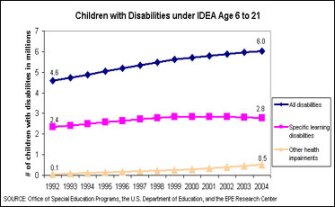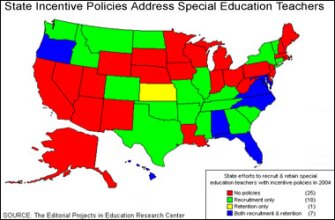
State Policies Address Shortages in Special Education Teachers
About 30 years ago the Education for All Handicapped Children Act (today known as the Individuals with Disabilities Education Act or IDEA), was signed to guarantee access to a free and appropriate education to all students with disabilities in the public school system. Part of providing that education to students is dependent upon the availability of a sufficient number of special education teachers. This week’s Stat of the Week looks at how the number of children with disabilities has changed over time from 1992 to 2004 and how states have responded with regard to recruiting and retaining special education teachers.
*Click image to view larger graphic.

The number of children age 6 to 21 with disabilities under IDEA was about 4.6 million in 1992 and grew steadily to about 6 million by 2004, representing a 31 percent increase over the 12-year period. This growth was due in large part to a rise in the number of children classified as having other health impairments* or specific learning disabilities, which together accounted for about 60 percent of the increase (and separately accounted for about 30 percent each). Specifically the total count of children with other health impairments increased from 65,531 in 1992 to 508,085 in 2004 while the number of children with specific learning disabilities grew from 2.4 million in 1992 to 2.8 million in 2004.
As the total numbers of students needing services under IDEA has risen, it has become more difficult for states to fill teaching positions. This may be exacerbated by more recent requirements under No Child Left Behind around the hiring of highly qualified teachers. One way in which states may be able to respond to the apparent teacher shortage however is by looking at their policies around recruitment and retention incentives. The Editorial Projects in Education Research Center defines recruitment incentives as bonuses or tuition assistance, and retention incentives as salary increases or retention bonuses.
*Click image to view larger graphic.

In 2004, seven states offered both recruitment and retention incentives for special education teachers. Six of the states are located in the mideast or southeast regions. Among the rest of the states, Kansas offered only retention incentives while 18 states offered only recruitment incentives for special education teachers. As a total, 26 states provided some kind of incentive to attract and keep special education teachers to their schools, while 24 states and the District of Columbia did not offer any kind of incentives.
* According to 34 Code of Federal Regulations §300.7(c)(9), “other health impairment means having limited strength, vitality or alertness, including a heightened alertness to environmental stimuli, that results in limited alertness with respect to the educational environment, that is due to chronic or acute health problems such as asthma, attention deficit disorder or attention deficit hyperactivity disorder, diabetes, epilepsy, a heart condition, hemophilia, lead poisoning, leukemia, nephritis, rheumatic fever, and sickle cell anemia; and adversely affects a child’s educational performance.”
To find out more about special education in the 50 states and the District of Columbia, access the Education Counts database.


